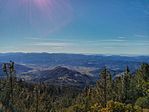Napa County, CA
| Napa County, California | ||||||
|---|---|---|---|---|---|---|
| County | ||||||
| County of Napa | ||||||
Images, from top down, left to right: Napa Valley welcome sign, Bale Grist Mill State Historic Park, a view of Calistoga from Mount Saint Helena, Lake Berryessa
|
||||||
|
||||||
 Location in the state of California |
||||||
 California's location in the United States |
||||||
| Coordinates: 38°30′N 122°19′W / 38.50°N 122.32°WCoordinates: 38°30′N 122°19′W / 38.50°N 122.32°W | ||||||
| Country | United States | |||||
| State | California | |||||
| Region | San Francisco Bay Area | |||||
| Incorporated | February 18, 1850 | |||||
| County seat | Napa | |||||
| Area | ||||||
| • Total | 789 sq mi (2,040 km2) | |||||
| • Land | 748 sq mi (1,940 km2) | |||||
| • Water | 40 sq mi (100 km2) | |||||
| Highest elevation | 4,203 ft (1,281 m) | |||||
| Population (April 1, 2010) | ||||||
| • Total | 136,484 | |||||
| • Estimate (2015) | 142,456 | |||||
| • Density | 170/sq mi (67/km2) | |||||
| Time zone | Pacific Time Zone (UTC−8) | |||||
| • Summer (DST) | Pacific Daylight Time (UTC−7) | |||||
| Area code | 707 | |||||
| FIPS code | 06-055 | |||||
| GNIS feature ID | 277292 | |||||
| Website | www |
|||||
Napa County is a county located north of San Pablo Bay in the northern portion of the U.S. state of California. As of the 2010 census, the population was 136,484. The county seat is the City of Napa. Napa County was one of the original counties of California, created in 1850 at the time of statehood. Parts of the county's territory were given to Lake County in 1861.
Napa County comprises the Napa, CA Metropolitan Statistical Area, which is also included in the San Jose-San Francisco-Oakland, CA Combined Statistical Area. It is one of four North Bay counties.
Napa County, once the producer of many different crops, is known today for its regional wine industry, rising to the first rank of wine regions with France by local wineries Stag's Leap Wine Cellars and Chateau Montelena winning the "Judgment of Paris" in 1976.
In prehistoric times, the valley was inhabited by the Patwin Native Americans, with possible habitation by Wappo tribes in the northwestern foothills. Most villages are thought to have been constructed near the floodplains of watercourses that drain the valley. Their food consisted of wild roots, acorns, small animals, earthworms, grasshoppers, and bread made from crushed California buckeye kernels. In winter they would construct huts made of tree branches. In summer they camped near rivers and streams. In winter months, they were half clad in wild animal skins and at other times they wore no clothing. The maximum prehistoric population is thought not to have exceeded 5000 persons.
...
Wikipedia






